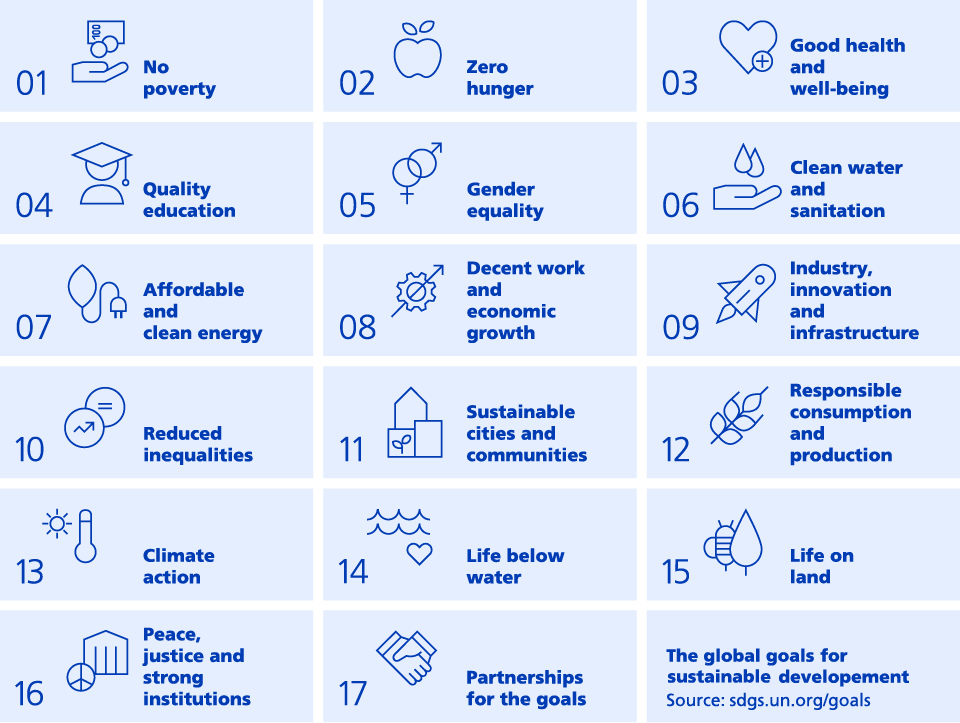UN Sustainable Development Goals (UN SDGs)
17 goals – from alleviating poverty to protecting the marine world
Our Sustainable funds help you to reconcile returns and investments in companies with social benefits. We focus on companies committed to at least one UN Sustainable Development Goal (UN SDG) (investments in SDG securities).

Companies committed to the UN Sustainable Development Goals can benefit from attractive growth opportunities and competitive advantages. According to the UN, they are expected to generate 12 trillion US dollars in GDP by 2030 and create 380 million new jobs by then. With the SDG analysis we use to invest in SDG securities, we discover companies that are still undervalued in the market. As the first step, we exclude all companies that violate an exclusion criterion. In the second step, we evaluate the influence on sustainability topics according to the UN's Sustainable Development Goals (UN SDGs) and filter for companies with a positive effect using our proprietary SDG framework, which links products and services to relevant sustainability goals (SDG leaders). Green bonds, social bonds or sustainable bonds are also possible. In the third step, we analyse these companies in a thorough, substantiated manner. Only companies that pass all three tests are included as SDG leaders in our Sustainable investment universe. Because the market still offers too little choice for a broadly diversified portfolio of SDG securities despite strong growth, we supplement our Sustainable investment universe with companies with an above-average ESG score (ESG leaders).

We also analyse states and SSAs (Sovereigns, Supranationals and Agencies) according to SDG and ESG criteria and invest in green bonds, social bonds or sustainable bonds (SDG leaders). Green bonds finance, for example, solar and wind power plants, other renewable energies, sustainable waste and water management or climate-efficient buildings and transport solutions. Social bonds are used to finance access to education, health, financial services, drinking water or low-cost housing, for example. Sustainable bonds finance activities to reduce negative effects on the environment as well as on society. Because the market for these bonds still offers too little choice for a broadly diversified portfolio despite strong growth, we supplement our Sustainable investment universe with countries that are among the best third of all countries according to our ESG score (ESG leaders).

As a sustainability pioneer, we defined six investment areas back in 2008. After the adoption of the 17 UN Sustainable Development Goals (UN SDGs) in 2015, we assigned them to our investment areas as follows:
Renewable energy and energy efficiency
Public transport and private transport
Clean water and resource efficiency
Access to basic care and health promotion
Access to financial services and financial infrastructure
Access to education and networking
The 17 Sustainable Development Goals (SDGs) are the core of Agenda 2030. They combine economic, social and environmental aspects and bring together poverty reduction and sustainable development for the first time. The goals are to be achieved worldwide by 2030. All UN member states, including Switzerland, are required to implement these goals at the national level. With the Sustainable Development Goals, the UN also aims to create incentives for non-state actors to play their part.

| Ending poverty | in all its forms and worldwide |
| Ending hunger | with greater food security, better nutrition and sustainable agriculture |
| Ensuring good health | and enabling healthy and liveable lives for all people of all ages worldwide |
| Enabling education | that is inclusive and high-quality, respects equal opportunities and promotes lifelong learning opportunities for all |
| Promoting equality | and empowering all women and girls to lead self-determined lives |
| Providing access to water | and enabling the availability and sustainable management of water and sanitation |
| Supplying clean energy | and securing affordable access for all |
| Creating decent work | based on sustainable economic growth |
| Building industry and infrastructure | and promoting inclusive and sustainable industrialisation and innovation |
| Reducing inequality | between all countries |
| Making cities and communities sustainable | and making them inclusive, safe and resilient |
| Promoting responsible consumption | and ensuring sustainable production |
| Implementing climate protection | and taking urgent action to combat climate change and its effects |
| Protecting habitats under water | Conserving and sustainably using the oceans, seas and marine resources |
| Protecting life on land | Restoring land ecosystems and promoting their sustainable use, sustainably managing forests, ending and reversing desertification and land degradation, as well as biodiversity loss |
| Creating peace | Facilitating peaceful and inclusive societies, providing access to justice for all, and creating effective, accountable and inclusive institutions |
| Building partnerships | and strengthening their means of implementation worldwide |
This website is aimed at professional/institutional investors from Switzerland. We are happy to address all other investors at swisscanto.com. Please confirm your client segment as a professional/institutional investor.